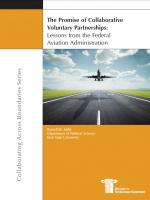
The Promise of Collaborative Voluntary Partnerships: Lessons from the Federal Aviation Administration

Based on his extensive research on the three programs, Mills concludes that although the programs can be improved, they are making a worthwhile contribution to airline safety. Mills argues that collaborative voluntary partnerships should be viewed as a complement to agency regulatory activities rather than as a replacement for the traditional command-and-control approach to regulation. Viewing voluntary activities as complementary to traditional regulatory activities will require a change in an organizational culture which has long considered the command-and-control approach its major regulatory option.
The focus of this report is quite timely given recent events prompting closer scrutiny of the relationship between government and industry. The Deepwater Horizon incident in the Gulf of Mexico has raised serious questions about the viability of real collaboration between the oil industry and its government regulator, the Minerals Management Service (now called the Bureau of Ocean Energy Management, Regulation, and Enforcement).
This report joins two recent IBM Center reports that have also examined the relationship between government agencies and private and nonprofit organizations. In their report, Food Safety—Emerging Public-Private Approaches: A Perspective for Local, State, and Government Leaders, Professors Noel P. Greis and Monica L. Nogueira recommend the creation of new co-regulation strategies to shape food safety policies that reflect mutual organizational and financial interests of both public and private sectors. Co-regulation activities might include setting risk-based inspection standards and jointly establishing best practices, enforcement, and monitoring approaches.
In another recent report, Strategies for Supporting Frontline Collaboration: Lessons from Stewardship Contracting, Cassandra Moseley describes collaborative partnerships created by the U.S. Forest Service and the Bureau of Land Management with both private companies and community-based nonprofit organizations to plan and execute land management initiatives, such as ecological restorations. Moseley found, as did Mills, that collaborative approaches require a major change in organizational culture.
We trust that this report will add to a broader body of knowledge regarding collaborative approaches that government managers can use to achieve more effective results. For example, the International Civil Aviation Organization might want to follow the FAA’s example and set up their own voluntary regulatory partnership programs to improve international air safety, and to mitigate the risk associated with countries having their own varying sets of safety rules.
Based on the IBM Center’s recent research, there is evidence that collaborative voluntary partnerships can serve as a useful complement to more
traditional regulatory activities. Finding the right mix should be high on the agendas of government regulatory agencies.



